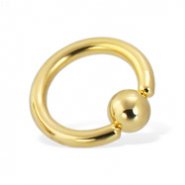Gold Tone Captive Bead Ring, 10 Ga
- Gauge (Thickness): 10 (2.5mm)
- Material: gold tone
- Type: captive bead ring
- -: priced and sold individually
| Click on the picture to see a big picture and description of the body jewelry you are interested in. | |||||||||
|---|---|---|---|---|---|---|---|---|---|
|
316L Surgical Stainless Steel CBR with...
$7.99
316L Surgical Stainless Steel CBR with Multi-Spiked Ball Dangle
|
Mega spike captive bead ring, 14...
$10.99
Mega spike captive bead ring, 14 ga
Shown: 14mm captive ring. |
Captive Bead Ring, 6 Ga
$7.49
Captive Bead Ring, 6 Ga
Shown: 13mm captive ring with 6mm ball. |
Captive bead ring with dangling key,...
$6.99
Captive bead ring with dangling key, 14 ga
|
||||||
Mammoth Ivory
Mammoth ivory is easily acquired in Alaska, Siberia and other places where it has been preserved underground in permafrost for thousands of years. Gold miners often find it during erosion mining in glacial silt. Because of itís age mammoth ivory is difficult to acquire in large solid pieces. Ivory is softer than most stone and is flexible which makes it ideal for intricate and delicate carvings. The foremost disadvantage of using aged or fossilized ivory for body jewelry is that it absorbs skin oils which causes it crack. Mammoth ivory ranges in color from a cream white to a medium brown. Darker ivory is more fragile and will crack with moisture much more easily, making it unsuitable for delicate work.




